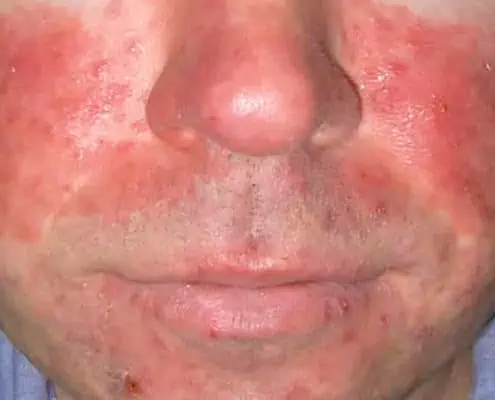
OC 949-428-4500
LA 310-460-2444
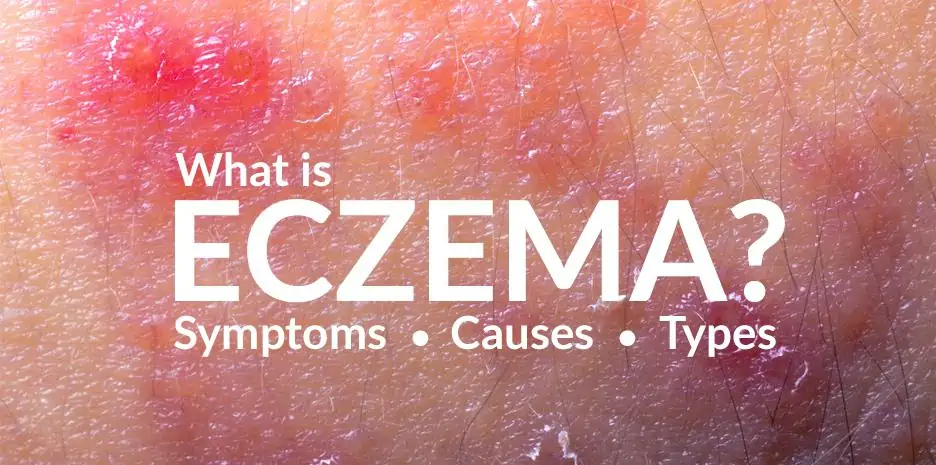
Why write an entire article on the different types of eczemas?
After all, they’re just rashes that can’t be cured and tend to go away on their own, right? While the above may be true, it’s also true that eczema is an issue for 10-12% of U.S. children and approximately 3% of adults. The drop in percentage of people affected is explicable through the fact that most children born with eczema will outgrow it by age 10.
However, the reality remains that there are 30 million Americans affected by this issue. Many sufferers go on experiencing the symptoms of eczema on and off all their lives. This warrants a detailed discussion of just what eczema is, how you can treat it, and why you should not let eczema embarrass you and overtake your life.When most people talk about eczema, they are actually typically referring to atopic dermatitis, which we discuss in detail below. For now, let’s focus on the scientific definition:
As a medical term, eczema refers to a family of skin conditions, which cause inflammation and irritation.
The term eczema is derived from the ancient Greek word for “effervescing”, i.e., “bubbling and boiling over”.
Eczema is a chronic condition, which means the rashes come and go: you may see periods where your skin is completely clear, only to then experience major flare-ups. In some cases, bouts of eczema rashes co-occur with hay fever or asthma attacks.
Eczemas can develop at any age and often affect several members of the same family. According to several experts, about one third of the world’s population will experience eczema at some point in their life.Most people are diagnosed with eczema as children and some continue to experience the symptoms even into adulthood. Developing eczema as an adult is comparatively rare. For most people, the symptoms will decrease in intensity over time and eventually disappear. However, people who develop eczemas in infancy will tend to have more sensitive skin as adults. They may remain prone to skin irritations, infections, and even dermatitis of the eyelids.
While eczemas can look and feel different from one patient to the next, they will usually have a couple of things in common. Below, check out some of the most frequently encountered symptoms of eczema. While you read them, bear in mind that, even if you may be experiencing all of them, only a certified medical professional can diagnose you with eczema.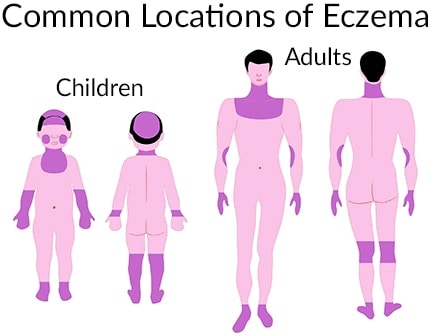
Eczemas can develop all over the human body. However, some areas tend to be affected more often than others. These include:
A patch of skin affected by eczema usually looks dry, scaly, and thickened – rough like leather, and discolored. In fair-skinned people, eczema spots will usually look reddened at first and then gradually become brown. In dark-skinned people, eczemas can significantly affect skin pigmentation, causing the patch in question to turn either lighter or darker in color.
Some infants affected by eczema will display particularly bad-looking rashes, with crust, oozing patches of skin. These typically emerge on their faces and scalps, but can pop up on any part of the body.Eczemas can range in intensity from mild, to moderate, to severe. Most people who suffer from eczema will have dry, flakey, sensitive skin, with a tendency for red spots and itchiness.
Unlike other types of skin conditions, eczemas can cause very intense itchiness – so bad that the sufferer will scratch until they literally bleed. This reaction will, in turn, activate the itch-scratch-itch cycle, wherein scratching will actually make the itchiness worse. To the right is how the itch-scratch-itch cycle works.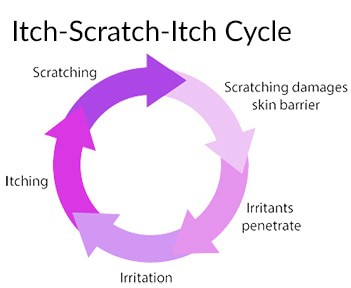
Some eczema rashes will turn into blisters; the skin can also crack, peel, ooze, and ‘weep’. Excessive scratching can not only cause further infections, but also turn the skin permanently rough and leathery.
A symptom to watch out for is the appearance of pus-filled blisters on affected skin patches, during an eczema flare-up. They might signal the presence of a bacterial infection, which requires antibiotic treatment. Never take antibiotics without a doctor’s prescription. Another condition these blisters might point to is eczema herpeticum, which we discuss in detail below (see ‘The different types of eczema’ section).
Sometimes, eczema rashes will be accompanied by the development of hives or bumps. Some sufferers develop an extra skin fold under their eyes.Many experts attribute the existence of eczema rashes to genetics, but this likely does not apply to all sufferers. Read on to find out what might be causing your eczema rashes and what definitely does not.
The short answer to the question ‘what causes eczema?’ is ‘we don’t know’—at least not yet. That being said, some correlations with other disorders have been established, as has the existence of certain frequently encountered triggers. Here they are, lined up for you:If someone in your family has suffered from eczema, seasonal allergies (such as hay fever), and/or asthma, you are more likely to develop eczema yourself. Up to 80% of children diagnosed with eczemas also suffer from hay fever.
A lesser known fact about developing eczema in early childhood, i.e., prior to the age of 2, is that you’re more likely to have this happen if you were born to an older mother. The exact causes for this remain unknown.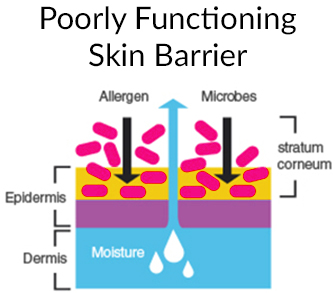
While eczema is not an allergy, it has ample co-occurrence with certain allergies, which has determined doctors to believe it is partly (or at least sometimes) associated with a poor immune response. It has also been ascertained that eczema can emerge when the skin barrier functions poorly, allowing moisture out and germs in.
The experts estimate that one third to two thirds of atopic eczema sufferers among the young also have a food allergy. It has thus been established that sufferers of eczema under the age of 1 develop it as a result of an allergic reaction to food.So, if eczema and some food allergies co-occur, does this mean removing the food allergens from a sufferer’s diet will solve the problem? Not necessarily. Before you decide that you or your child should stop having eggs, milk, or nuts, consult with a registered medical practitioner. Furthermore, a higher incidence of flare-ups has been recorded in people which experience conditions that affect their immunity. These include:
Science has established certain correlations between environmental factors and the development of eczema. In terms of demographic profiles of sufferers, it turns out eczema is more common among kids who:
There are plenty of allergens, activities, and irritants, which have been linked to a worsening in eczema symptoms. Here are some of them, categorized by type:


You risk developing dyshidrotic eczema, AKA “hand eczema”, if you:
The condition is characterized by the appearance of small vesicular pustules (or blisters) on the hands and feet, including the edges of your fingers and toes, your palms, and your soles. These can be itchy; breaking the blisters can cause inflammation, scaly skin, and pain.
This condition seems to emerge during particular times of the year. It is only present in teens and adults and it can be chronic, acute, or recurrent. In terms of severity, it can be self-limited, but can also range to debilitating. The condition is usually unresponsive to treatment and tends to disappear in 2-3 weeks’ time on its own. In rare cases, when the sufferer is affected by bacterial infection, nail changes, cellulitis, and even septicemia may develop.
To keep the condition in check, try to avoid irritants and use emollients as often as possible.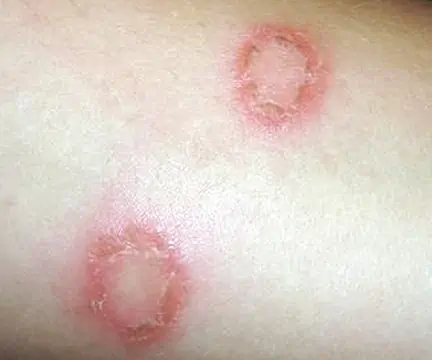
The coin-shaped lesions will usually emerge on the arms and legs, but they can also expand to the chest. They can be pink, brown, or red, and in terms of texture, they’re itchy, oozing, scaly, and even crusty. The skin around them is also usually inflamed, raw, and scaly.
For an accurate diagnosis, your doctor may run several different types of tests, including skin biopsies, allergy tests, blood tests, and challenge tests. They will also ask about your medical history to rule out other diagnoses. While there is no cure for this type of eczema, some lifestyle changes, such as avoiding cuts, rough fabrics, stress, irritants, and hot waters, may be recommended. Similarly, you might be asked to wear bandages over the lesions, take cortisone or antihistamines, and undergo UV light treatment.
It usually causes a fever and lymphadenopathy, as well as many blisters on top of former eczema patches. This condition, which is disseminated, can be fatal for babies. That’s because it affects many internal organs, including the liver, lungs, and brain, as well as the eyes.
To treat it, your doctor will typically prescribe antiviral drugs like acyclovir, valganciclovir, and Foscarnet. The latter name on the list is also prescribed to the immunocompromised carrier of the virus, as well as to strands which are acyclovir-resistant.There are many myths that have been propagated and perpetuated with regards to eczema. The truth is modern medicine still can’t pinpoint a precise cause for the apparition of eczema rashes. But what we do know is that these things are clearly not the causes:
Myth #1: All eczemas are caused by food allergies. In some cases, allergies to specific foods co-exist with eczema. However, no such indisputable link has been established, so there’s no need to undertake a strict ‘elimination’ diet. Similarly, if you’re a breastfeeding mother and your infant has developed eczema, doctors don’t recommend that you stop breastfeeding. The link between food allergies and eczema is correlation, not causation.
Myth #2: Eczema is caused by a “leaky gut”. This valid medical term designates a condition within which your gut “leaks” waste, microbes, partly digested food, and various toxins into your body. Even though there is some similarity between this and an eczema, in which your skin ‘leaks’ layers, no connection between the two disorders has been established.
Myth #3: Eczema is caused by the weather. There is some validity to this myth, in that some patients tend to experience flare-ups in hot, humid climates, while others experience them in cold, arid ones. However, each case seems to be unique in its response to climate conditions, so no definitive causation link can be determined in this sense.
Myth #4: Eczema is caused by excess bathing. Yet again, there’s some truth to this claim. To avoid eczema breakouts, avoid the following:
However, don’t skip bathing altogether because of this! Simply make sure to use mildly warm water, to minimize skin damage and infections. Always check the ingredients of your bathing products and pick mild, non-irritant, hypoallergenic options.
Some doctors will prescribe ‘soap and seal’ baths, which involve adding a small capful of bleach to your bath water. Bleach is an anti-bacterial agent, which can do away with any harmful organisms living on your skin. Follow each such bath with a full-body application of lotion or alcohol-free cream.
AMA Regenerative Medicine & Skincare | 1570 Brookhollow Dr., Santa Ana, CA 92705 | 6310 San Vicente Blvd STE 285, Los Angeles, CA, 90048 | Privacy Policy